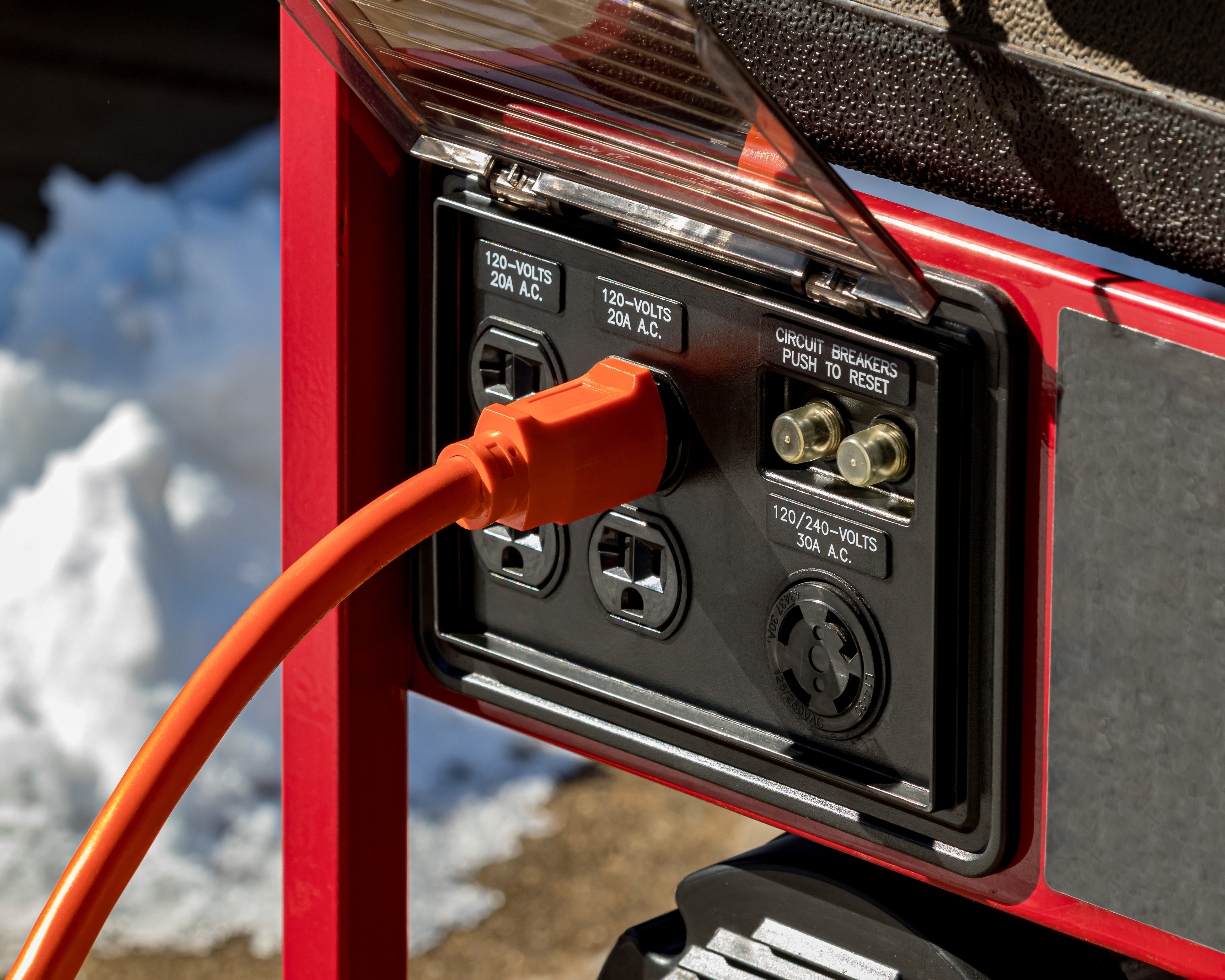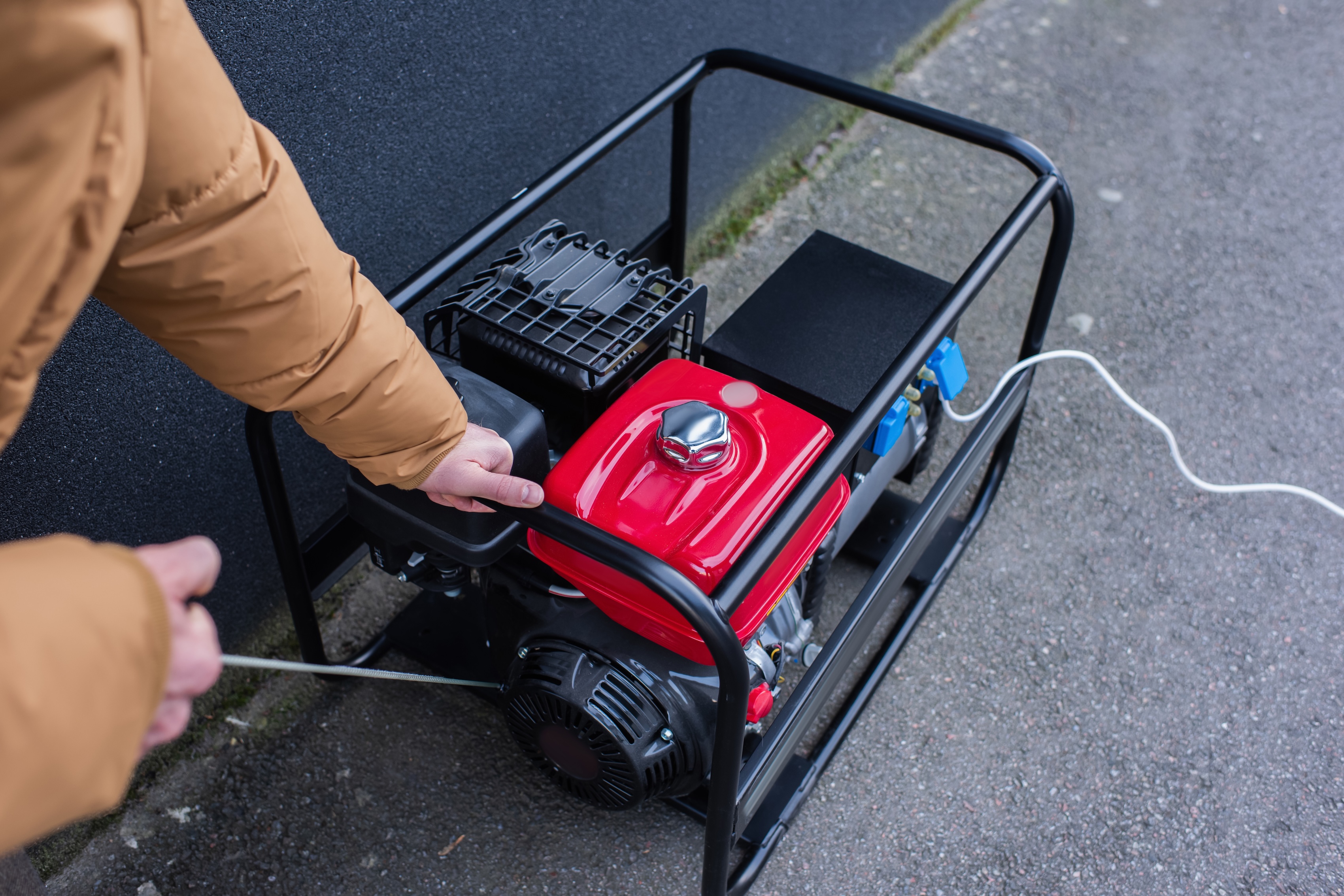How to Use a Portable Generator: Prep, Maintenance, & Use
Use a portable generator safely during Midwest winters. Learn about generator types, fuel storage, cold-weather tips, and maintenance needs.

Knowing how to use a portable generator makes a significant impact during winter in the Midwest. When snow, ice, and freezing temperatures knock out power, a generator keeps your home warm and your family comfortable and safe. Below, we’ll walk you through how to choose, run, and maintain a portable generator during cold-weather months.
Why a Portable Generator Comes in Handy During Midwest Winters
Winter weather in the Midwest is unpredictable, and it’s even harder on the power grid. Ice, wind, and heavy snow often lead to outages that last for hours or even days. If you don’t have backup power, you might lose heat, risk frozen pipes, and end up throwing out food that goes bad in the fridge or freezer.
Portable generators allow you to keep essentials running until the lights come back on. They’re especially beneficial when temperatures drop below freezing and staying warm becomes vital to survival.
Research shows that 22% of major power outages across the U.S. are caused by winter weather events like snow, ice, or freezing rain. The Midwest is hit particularly hard because many areas rely on older infrastructure that’s more likely to fail in cold conditions.
Choosing the Best Portable Generator
Not all portable generators work for every home. Some are better for the basics, while others can handle more of your household needs. Before buying one, you’ll want to understand the different types and sizes available, especially for winter use.
Product Spotlight: Generac GP 3600 212cc Portable Generator Power essential appliances during outages with this durable, winter-ready generator. Features include PowerRush™ boost, COsense® safety shutoff, and easy portability for Midwest storms.
Conventional vs. Inverter Generators
When comparing inverter vs. conventional generator models, the proper choice depends on what you need to power and how you’ll use it.
Conventional generators are known for their strength. They’re often more affordable and come in larger wattage ranges, typically between 3,000 and 17,500 watts. These units are a solid option if you need to run multiple larger appliances. Remember, though, that they’re louder and generally use more fuel.
Inverter generators run more quietly and produce cleaner power. This makes them better for sensitive electronics such as laptops or smart appliances. They adjust their engine speed depending on the load, too, which saves fuel over time.
Here’s a quick breakdown of inverter types:
- Small Inverter (Up to 2,000W): great for light loads or quick jobs.
- Midsize Inverter (2,000-3,500W): a good balance of power and portability.
- Larger Inverter (5,000-7,500W): works with a transfer switch to power key home circuits.
Product Spotlight: Honda EU3000is 3000W 120V Portable Inverter Generator This quiet, fuel-efficient generator is ideal for home backup or RV use. It’s safe for electronics and runs up to 20 hours on a single tank.
Sizing Your Generator Based on Home Needs
To pick the correct generator, begin by adding up the running wattage of everything you want to power. Then, include the highest starting wattage of any motor-powered items, like a fridge or well pump. That total gives you the minimum wattage your generator should handle.
For example:
- Refrigerator: 725W
- Well Pump: 500W running / 1,500W starting
- Window AC Unit: 900-3,000W depending on size
Look for a generator that covers your total needs with a little extra room. This will ensure you avoid overloads and keep things running properly.
Product Spotlight: Generac GP6500 6500W 120V/240V 49ST Gas Powered Portable Generator With 6,500 running watts and 8,125 starting watts, this model is a solid choice for powering key circuits during an outage—especially when using a transfer switch.
Fuel Types and Cold-Weather Considerations

Cold weather affects how well your generator runs and how easy it is to keep it going. Choosing the correct fuel type and storing it properly are key steps to ensuring your generator is ready when you need it.
Gasoline, Propane, Diesel, and Dual-Fuel Options
Each fuel type has its pros and cons. Here’s a breakdown so you can decide:
- Gasoline is the most common and easiest to find. However, it has a shorter shelf life and can gum up your carburetor if you don’t use a stabilizer.
- Propane burns cleaner and stores much longer than gas. It doesn’t offer as much energy per gallon, but it’s a good option if you want something low-maintenance.
- Diesel is efficient and gives you better fuel economy. It’s also known for longer engine life and fewer maintenance needs.
- Dual-fuel generators can run on either gasoline or propane. This gives you more flexibility during a power outage when one fuel might be easier to get than the other.
How long will a portable generator run on one tank of gas? Most portable generators with gasoline tanks last 6 to 18 hours on a full tank, depending on fuel capacity, load, and efficiency. For example, a 5-gallon tank typically runs around 7 to 10 hours at 50% load.
Fuel Storage Tips for Winter
Proper fuel storage is just as important as picking the correct type. Cold temperatures make some fuels harder to manage, and safety should always come first.
- Use approved gas containers, like red safety cans, and store them in a cool, dry place away from any flames or sparks.
- Leave some space in the container for expansion, especially in freezing temperatures.
- Add fuel stabilizer and rotate your stored gas once a year to keep it fresh.
- If your generator won’t be used for a while, drain the fuel or treat it with stabilizer to prevent damage.
- Propane is easier to store long-term and won’t go bad like gasoline.
<div class="rt-cta"><a class="cta-link-button inline-link" href="https://www.fleetfarm.com/category/tires-automotive/garage/fluid-storage-handling/gas-cans/_/N-4195001600">Shop gas cans at Fleet Farm for safe fuel storage solutions</a></div>
Safe Setup and Operation in Winter
Cold weather adds a few extra steps when setting up your generator. Following safety guidelines ensures you avoid accidents and that the generator runs properly, even in freezing temperatures.
Generator Placement and Ventilation
Always run your generator outside and far enough away from windows, doors, or vents. Even though it may be cold, never bring a generator indoors or into an enclosed space like a garage or shed.
- Place the generator 15 to 25 feet from your home or other structures.
- Keep at least 3 feet of open space on all sides so air can move freely.
- If snow or sleet is in the forecast, use a weather-rated generator cover that allows for proper airflow and keeps the unit dry.
Related Article: Preparing Your Vehicle for Winter Snow Just like a portable generator keeps your home running during an outage, a well-prepared vehicle helps you stay safe during winter travel. Learn how to winterize your car so you’re ready for both roadside emergencies and power failures at home.
Carbon Monoxide Safety Must-Knows
Portable generators produce carbon monoxide (CO), a colorless, odorless gas that can be deadly in minutes if it builds up indoors.
- Install battery-powered CO detectors near all sleeping areas.
- If you or someone else feels dizzy, nauseated, or confused, get fresh air immediately. Those are signs of CO exposure.
- Make sure detectors meet UL (Underwriters Laboratories) or CSA (Canadian Standards Association) standards, and test them monthly to ensure they work.
- Always point the generator’s exhaust away from your home or other occupied areas.
Portable generators can create high levels of carbon monoxide, which is dangerous enough to be fatal within minutes.
Extension Cords vs. Transfer Switches

There are two common ways to connect a generator to your home’s appliances: extension cords or a transfer switch. Each one has its place, but there are safety rules to follow.
Extension Cords:
- Use only heavy-duty, outdoor-rated cords. Look for ones labeled 12-gauge or thicker.
- Never connect multiple cords together (also called “daisy-chaining”).
- Inspect cords for wear before each use.
Transfer Switches:
- Installed by a licensed electrician, these let you power multiple circuits in your home safely.
- A transfer switch connects your generator directly to your home’s electrical panel, avoiding the need to run cords through windows or doors.
OSHA (Occupational Safety and Health Administration) requires a minimum 12-gauge cord for construction-level power tools, and warns against daisy-chaining cords due to fire and electrical risks. These same safety practices apply to generators at home.
Can I plug a refrigerator directly into a generator? Yes, you can plug a refrigerator directly into a portable generator using a heavy-duty, outdoor-rated extension cord. Just make sure the generator’s wattage covers the fridge’s starting and running power. Most refrigerators need around 600–800 running watts but can spike to 1,500 watts or more at startup. Always follow the generator’s safety guidelines to avoid damage or fire risk.
Starting and Running Your Generator in Cold Conditions

Getting a generator up and running in freezing weather requires some extra prep. These steps make sure your generator starts when you need it and keeps it running safely through the cold.
Pre-Start Checklist
Before you fire up your generator, take a minute to do a quick inspection:
- Check the oil and fuel levels. Top off both if needed.
- Look over the air filter and cords. Make sure everything is clean and in good shape.
- Confirm proper grounding. Some generators need to be grounded to avoid shocks.
- Clear the area around the generator. Check for snow, ice, or anything that might block airflow.
- Unplug all devices before starting to prevent surges.
Product Spotlight: Reliance 30 Amp 6-Circuit Indoor Portable Generator Transfer Switch Kit This indoor transfer switch kit safely connects your generator to up to six circuits during a power outage. Supports 30-amp service.
Cold Weather Starting Tips
Cold temperatures make starting a generator a bit harder, but these tips are useful:
- Use the choke when starting, then switch it to “run” once the engine warms up.
- Store your generator in a warmer spot if you can, like a shed or garage, but always run it outside.
- Use synthetic 5W-30 oil, which flows better in low temperatures than standard oil.
- If your generator has an electric start, keep the battery charged. Consider using a battery warmer if temperatures regularly drop below freezing.
For temperatures below 32°F, generators should use 5W-30 oil instead of standard 10W-30 oil to ensure proper lubrication and starting in cold conditions.
Generator Maintenance for Reliability
Taking care of your generator isn’t difficult, but it does need to be done often, especially if you want it to start up without trouble in the middle of winter. A little upkeep goes a long way toward making sure your portable generator is ready when you need it the most.
Routine Maintenance Schedule
Stick to a simple routine to keep your generator in good shape:
- Every Use: Check the oil level and fuel. Look over the unit for cracks, loose parts, or leaks.
- Every 50 Hours: Change the oil, clean the air filter, and inspect the spark plug.
- Annually: Replace the air and fuel filters, inspect the valves, and test the system under load to ensure it runs as expected.
Also, don’t forget the generator break-in procedure for new units:
- Change the oil after the first 5 to 10 hours of use.
- Run the generator with no load at first so the engine parts settle in.
- Vary the load gently during the first few hours to keep things balanced.
Oil Changes and Fuel System Care
Oil changes are one of the most essential parts of portable generator maintenance. Here’s what to know:
- Change the oil every 50 to 100 hours, depending on the model and how hard it’s working.
- In cold weather, use synthetic 5W-30 oil for better starting and protection.
- Drain the fuel or add stabilizer if you won’t be using the generator for a while.
- Inspect fuel lines at least once a year, and clean the carburetor if you notice rough starts or sputtering.
Emergency Power Planning and Load Management
Some preparation ahead of time makes it much easier to use your generator during an outage. Figuring out what you need to power and how much fuel you’ll need keeps you prepared when the lights go out.
Related Article: Snow Blowers: Everything You Need to Know Looking for more winter workhorse options? This guide breaks down snow blower types, features, and tips so you can clear driveways and sidewalks fast when storms hit.
Prioritizing Critical Circuits
During a power outage, you might not be able to run everything at once. That’s why it’s essential to figure out ahead of time what actually needs power.
Focus on essentials like:
- Furnace blower or space heater
- Refrigerator and freezer
- Lights in key areas
- Medical equipment, if anyone in your home depends on it.
Once you know what’s most important, you can plan your setup around those items. Labeling your circuits and noting their wattage lets you act quickly during an emergency.
Managing Fuel Supply During Outages
Running out of fuel during an outage is frustrating, and it puts your backup power on pause when you need it.
Here’s how to stay ahead:
- On average, generators use about 0.5 to 0.75 gallons per hour at 50% load. A full 5-gallon tank can last 6 to 10 hours.
- Store up to 25 gallons of fuel if your local codes allow it.
- Keep extra propane tanks filled and ready if you’re using a propane or dual-fuel model.
- Rotate gasoline every few months if you don’t add stabilizer, or once a year if you do.
Winter Storage and Long-Term Generator Care
When winter ends or your generator won’t be used for a while, take a few steps to prepare it for storage. Begin by draining the fuel or adding stabilizer so it doesn’t break down inside the tank or carburetor. Change the oil, clean or replace the filters, and wipe down the unit to remove any dirt or debris.
If your generator has a battery, store it indoors in a dry, warm place. During the off-season, run the generator once a month to keep everything working properly.
Is it worth it to have a portable generator? Yes—especially in the Midwest. A portable generator keeps essentials running during outages, helping you avoid spoiled food, frozen pipes, and cold indoor temps. It’s peace of mind when storms hit.
Shop Portable Generators and Cold-Weather Accessories at Fleet Farm
Knowing how to use a portable generator safely and effectively is essential during a Midwest winter. Are you powering a few essentials or preparing for extended outages? Having a plan and the proper equipment keeps your home up and running when you need it.
Key Takeaways:
- Portable generators are a reliable backup when winter weather knocks out power.
- Choosing the correct size and fuel type makes everything easier and more efficient.
- Regular maintenance and safe storage ensure your generator lasts longer.
Next Steps:
- Make a list of your must-have items to power during an outage.
- Choose a generator that matches your wattage needs and winter conditions.
- Stock up on fuel, stabilizers, and cold-weather accessories before the snow hits.
<div class="rt-cta"><a class="cta-link-button inline-link" href="https://www.fleetfarm.com/category/home-improvement/tools/outdoor-power-tools/generators/_/N-675630299">Explore Fleet Farm’s full selection of dependable portable generators and cold-weather accessories to get prepared for winter outages</a></div>












